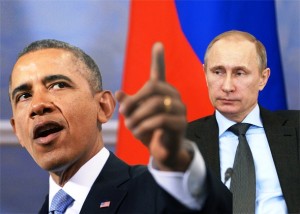 In early August, the death of Armenian and Azerbaijani soldiers as a result of conflict in Nagorno- Karabakh area brought a new tension. Nagorno Karabakh, a succession of Soviet and dispute area between Armenia and Azerbaijan, became a tool that maintains the severity of Caucasus in the last 20 years.
In early August, the death of Armenian and Azerbaijani soldiers as a result of conflict in Nagorno- Karabakh area brought a new tension. Nagorno Karabakh, a succession of Soviet and dispute area between Armenia and Azerbaijan, became a tool that maintains the severity of Caucasus in the last 20 years.
After the biggest conflict of the recent years, Russian Leader Vladimir Putin assumed the role of mediator by hosting the presidents of two countries, Serzh Sargsyan and Ilham Aliyev in Sochi. This mediation effort was also inconclusive like the other ongoing efforts.
The inactive Caucasus policy of the United States that increased the severity in different fields since 1990s are still being discussed in the context of Nagorno-Karabakh. After the disintegration of the Soviet Union, the followed policy of the United States, which pursued a dominant policy in Russia and Iran, is changing the balance of the region as US is not going on its previous policy.
The United States that followed to a successful path in supporting alienate two countries without giving affront through pursuing different support policies towards Armenia because of its interest to Azerbaijani oil made significant expansion about Nagorno Karabakh issue. At the beginning of 1990s, incorrect policies were followed, but especially during George W. Bush era it can be said that there was stability. For example, as a result of intensive efforts by Armenian lobby in the very first years, because of the claims such as Azerbaijani blockade in Armenia and creating a threat in Karabakh, the US aid to Azerbaijan was barred. The financial aid possibility was declared invalid only for Azerbaijani with the Section 907 of the Freedom Support Act. Until 2000, the United States’ taking part in the Baku-Tbilisi-Ceyhan Project which opened the oil of Azerbaijan to the world and allowing this project pipeline bypassing Yerevan was protested by Armenians and the Armenian lobby in US. Recognizing the sensitivity of both sides, Washington started a politics considering Armenian lobby, Armenia-Azerbaijan equation in order to follow up a strong balance policy. Ultimately, the United States was not as experienced as Russia about these countries.
There were two reasons of the Cold War between the United States and Russia. The first one is the Baku-Tbilisi- Ceyhan Project which helps to transfer Caspian Oil to West. The United States preferred to play a dominant role against Russia and Iran with this Project. The second one is the Nagorno-Karabakh parleys. The United States that was conducting the co-chairmanship in Minsk Group which was established by Russia and France to solve the Karabakh issue, showed very important approaches to the issue during Bill Clinton and George W. Bush eras. It was apparent that Baku and Yerevan needed the suggestions and attempts of the United States except for Russia.
After the September 11 terrorist attacks, the cooperation with Caucasus, which was becoming increasingly important for US, against terrorism created Washington-Baku and Moscow-Yerevan axis and Armenia came under the influence of Russia during this natural alliance. However, it can be said that US did not neglect Yerevan during its economic aid to Armenia and mediation activities about Karabakh issue. But there is no other effective US policy approach towards the Balkan conflicts during Clinton era.
The US policy with a decreasing interest to Azerbaijan and Armenia conflict towards the end of the Bush era changed direction with the president Barack Obama era. According to the new approach, the United States would actualize the normalization process between Armenia and Turkey, then would find a reasonable solution to Karabakh issue with the support of Turkey. Because, the strong relations of Armenia, which was completely under the control of Russia, with Iran, another neighbor, was a type of relation which US could not approve.
President of Turkey, Abdullah Gul and President of Armenia, Serzh Sargsyan started the normalization process supported by the United States with watching the Turkey-Armenia national match in Yerevan in 2008 which took part in literature as “Football Diplomacy” after this event. One year later, the establishment of the basic protocol process that would start the normalization was the last straw for Russia.
By 2000, Moscow, which suppressed Yerevan, continued its attempts to disrupt the normalization process. While facing various demands of Armenian lobby, Obama remained in between giving utterance to the word genocide referred as “G-word” and going on the process of normalization. While stating his sadness about the tragedy of Ottoman Armenians in 1915, Obama was indicating normalization process should go on with the same determination.
The initiative by the United States that wanted to turn over a new leaf failed because of the rapprochement of Turkey-Armenia. This reflects the dwindling performance of the United States in Azerbaijan-Armenia-Turkey axis since 1990.
It is possible to see similar other examples in Georgia and Ukraine during Bush era. First and foremost, the victories won against Russia in a short time have turned against the United States. In the last few years, the situation of the inactive role of the US about ethnical and regional conflicts mainly the Karabakh issue in Caucasus may lead new problems. Russia’s sustaining the severity as the only mandatory power in the region suggests arise of a new Soviet Union after Cold War era.
Mehmet Fatih ÖZTARSU

 Eylül 8th, 2014
Eylül 8th, 2014  oztarsu
oztarsu  Posted in
Posted in  Tags:
Tags: